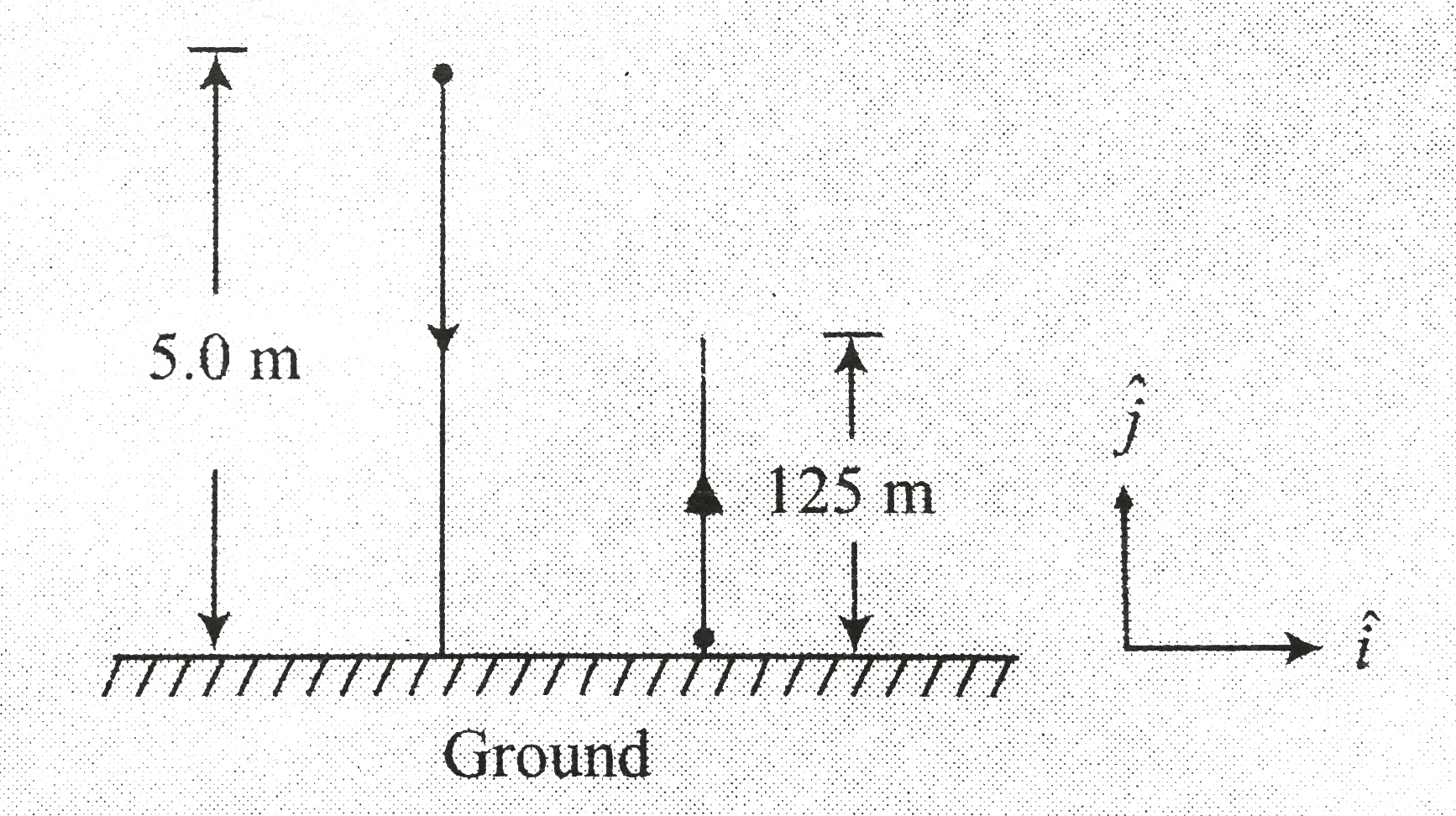A ball of mass 100 gram falls from 20 m height on floor and rebounds to 5m. Time of contact is 0.02s. Find average force acting on it during impact. (g = 10 m/s2)
120 N
100 N
200 N
150 N
The correct Answer is:D
To find the average force acting on the ball during impact, we can follow these steps:
Step 1: Determine the mass of the ball
The mass of the ball is given as 100 grams. To convert this to kilograms:
Mass (m)=100 grams=0.1 kg
Step 2: Calculate the velocity just before impact
The ball falls from a height of 20 m. We can use the kinematic equation:
v2=u2+2as
where:
- u=0 (initial velocity),
- a=g=10m/s2 (acceleration due to gravity),
- s=−20m (displacement, negative because it falls down).
Substituting the values:
v2=0+2×10×20
v2=400⟹v=−20m/s(negative sign indicates downward direction)
Step 3: Calculate the velocity just after impact
The ball rebounds to a height of 5 m. Using the same kinematic equation:
v2=u2+2as
where:
- u=0 (final velocity after rebound),
- a=−10m/s2 (deceleration due to gravity),
- s=5m (displacement, positive because it goes up).
Substituting the values:
0=u2+2×(−10)×5
0=u2−100⟹u2=100⟹u=10m/s(positive sign indicates upward direction)
Step 4: Calculate the change in momentum
The change in momentum (Δp) during the impact can be calculated using:
Δp=m(v−u)
where:
- v=10m/s (upward velocity after rebound),
- u=−20m/s (downward velocity just before impact).
Substituting the values:
Δp=0.1kg×(10−(−20))=0.1kg×(10+20)=0.1kg×30=3kg m/s
Step 5: Calculate the average force
The average force (F) can be calculated using the formula:
F=ΔpΔt
where Δt=0.02s.
Substituting the values:
F=3kg m/s0.02s=150N
Conclusion
The average force acting on the ball during impact is 150N.
---
The mass of the ball is given as 100 grams. To convert this to kilograms:
Mass (m)=100 grams=0.1 kg
The ball falls from a height of 20 m. We can use the kinematic equation:
v2=u2+2as
where:
- u=0 (initial velocity),
- a=g=10m/s2 (acceleration due to gravity),
- s=−20m (displacement, negative because it falls down).
v2=0+2×10×20
v2=400⟹v=−20m/s(negative sign indicates downward direction)
The ball rebounds to a height of 5 m. Using the same kinematic equation:
v2=u2+2as
where:
- u=0 (final velocity after rebound),
- a=−10m/s2 (deceleration due to gravity),
- s=5m (displacement, positive because it goes up).
0=u2+2×(−10)×5
0=u2−100⟹u2=100⟹u=10m/s(positive sign indicates upward direction)
The change in momentum (Δp) during the impact can be calculated using:
Δp=m(v−u)
where:
- v=10m/s (upward velocity after rebound),
- u=−20m/s (downward velocity just before impact).
Δp=0.1kg×(10−(−20))=0.1kg×(10+20)=0.1kg×30=3kg m/s
The average force (F) can be calculated using the formula:
F=ΔpΔt
where Δt=0.02s.
F=3kg m/s0.02s=150N
The average force acting on the ball during impact is 150N.
Topper's Solved these Questions
- BOOK - VMC MODULES ENGLISHCHAPTER - DYNAMICS OF A PARTICLEEXERCISE - LEVEL 249videos
DYNAMICS OF A PARTICLE
- BOOK - VMC MODULES ENGLISHCHAPTER - DYNAMICS OF A PARTICLEEXERCISE - LEVEL 2 ( NUMERICAL TYPE FOR JEE MAIN )16videos
DYNAMICS OF A PARTICLE
- BOOK - VMC MODULES ENGLISHCHAPTER - DYNAMICS OF A PARTICLEEXERCISE - LEVEL 0 (LONG ANSWER TYPE)4videos
DYNAMICS OF A PARTICLE
- BOOK - VMC MODULES ENGLISHCHAPTER - DC CIRCUITEXERCISE - JEE ADVANCED ARCHIVE68videos
DC CIRCUIT
- BOOK - VMC MODULES ENGLISHCHAPTER - ELECTROMAGNETIC INDUCTION & ALTERNATING CURRENTEXERCISE - IN-CHAPTER EXERCISE-G10videos
ELECTROMAGNETIC INDUCTION & ALTERNATING CURRENT
Similar Questions
A rubber ball of mass 50 g falls from a height of 5m and rebounds to a height of 1.25 m. Find the impulse and the average force between the ball and the ground if the time for which they are in contact was 0.1s
 View Solution
View SolutionA ball of mass 1 kg is dropped from 20 m height on ground and it rebounds to height 5m. Find magnitude of change in momentum during its collision with the ground. (Take g=10m/s2)
View SolutionA ball is dropped from a height of 20 m in the floor and rebounds to 1.25 m after second collision, then coefficient of restitution e is
View SolutionA tennis ball is dropped on the floor from a height of 20m. It rebounds to a height of 5m. If the ball was in contact with the floor for 0.01s. What was its average acceleration during contact? (g=10m/s2)
View SolutionA metal ball of mass 60 g falls on a concrete floor from a vertical height of 2.8 m and rebounds height of 1.3 m. Find the change in K.E. in S.I. units.
View SolutionA ball falls on the ground fro a height of 2.0 m and rebounds up to a height of 1.5 m. Find the coefficient of restitution.
View SolutionA body of mass 0.2 kg falls from a height of 10 m to a height of 6 m above the ground. Find the loss in potential energy taking place in the body.
[g=10ms−2]View SolutionA ball of mass 10 g falls from a height of y 5 m. It rebounds from the ground to a height of 4m. Find :
(a) the initial potential energy of the ball, (b) the kinetic energy of the ball just before the ground. striking the ground,
(c) the kinetic energy of the ball after striking the ground ,and
(d) the loss in kinetic energy on striking the ground .
Take g=9.8 m s−2.View SolutionA ball dropped on to the floor from a height of 10 m rebounds to a height of 2.5 m. If the ball is in contact with the floor for 0.02s, its average acceleration during contact is
View SolutionA ball dropped on to the floor from a height of 40 m and rebounds to a height of 10 m. If the ball is in contact with the floor for 0.02 s, its average acceleration during contact is
View Solution

